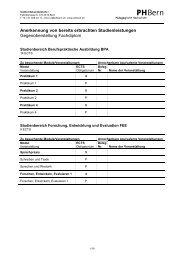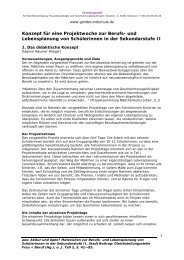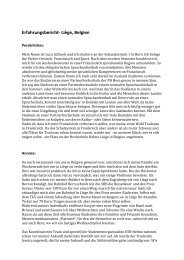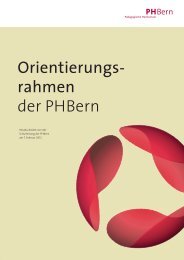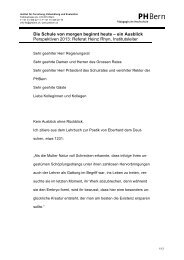Gender an der Mittelschule - PHBern
Gender an der Mittelschule - PHBern
Gender an der Mittelschule - PHBern
Sie wollen auch ein ePaper? Erhöhen Sie die Reichweite Ihrer Titel.
YUMPU macht aus Druck-PDFs automatisch weboptimierte ePaper, die Google liebt.
32<br />
LITERATUR<br />
Abell, S<strong>an</strong>dra K./ Le<strong>der</strong>m<strong>an</strong>, Norm<strong>an</strong> G. (Hrsg.) (2008): H<strong>an</strong>dbook of Research<br />
in Science Education. New York, Routledge.<br />
Allchin, Douglas (2011): The Minnesota Case Study Collection: New Historical<br />
Inquiry Case Studies for Nature of Science Education. In: Science & Education,<br />
DOI 10.1007/s11191-011-9368-x.<br />
Arteaga, Ju<strong>an</strong> M. S./ El-H<strong>an</strong>i, Charbel N. (2011): Othering Processes <strong>an</strong>d STS<br />
Curricula. In: Science & Education, DOI 10.1007/s11191-011-9384-x.<br />
Baptista, Geilsa C. S./ El-H<strong>an</strong>i, Charbel N. (2009): The Contribution of Ethnobiology<br />
to the Construction of a Dialogue Between Ways of Knowing (...).<br />
In: Science & Education, DOI 10.1007/s11191-008-9173-3.<br />
Baron-Cohen, Simon (2004): Vom ersten Tag <strong>an</strong> <strong>an</strong><strong>der</strong>s.<br />
Das weibliche und das männliche Gehirn. Düsseldorf / Zürich, Walter.<br />
Bell, R<strong>an</strong>dy / Abd-El-Khalick, e.a. (2001): The Nature of Science <strong>an</strong>d Science<br />
Education: A Bibliography. In: Science & Education 10, S. 187– 204.<br />
Berck, Karl-Heinz / Graf, Dittmar (2010): Biologiedidaktik. Grundlagen und<br />
Methoden. 4. Auflage, Wiebelsheim, Quelle & Meyer.<br />
Birke, Lynda (1999): Feminism <strong>an</strong>d the Biological Body. Edinburgh,<br />
Edinburgh University Press.<br />
Bleier, Ruth (1984): Science <strong>an</strong>d <strong>Gen<strong>der</strong></strong>. A Critique of Biology <strong>an</strong>d its Theories<br />
on Women. New York, Pergamon Press.<br />
Bleier, Ruth (1986): Feminist Approaches to Science. New York, Pergamon Press.<br />
Brizendine, Lou<strong>an</strong>n (2007): Das weibliche Gehirn.<br />
Warum Frauen <strong>an</strong><strong>der</strong>s sind als Männer. Hamburg, Hoffm<strong>an</strong> und Campe.<br />
Buss, David (2004): Evolutionäre Psychologie. 2. Auflage, München, Pearson.<br />
Carter, Lyn (2004): Thinking differently about cultural diversity: Using postcolonial<br />
theory to (re)read science education. In: Science Education 88 (6), S. 819 – 836.<br />
Eicher, Eva / Washburn, Linda L. (1986): Genetic Control of primary Sex<br />
Determination in Mice. In: Annual Review of Genetics 20, S. 327-360.<br />
Etschenberg, Karla (1998): Der «kleine» Unterschied – und was bei seiner Thematisierung<br />
im Unterricht zu bedenken ist. In: Bayrhuber, Horst / Etschenberg,<br />
Karla / Gebhard, e.a (Hrsg.): Biologie und Bildung. Kiel, Institut für die Pädagogik<br />
<strong>der</strong> Naturwissenschaften, S. 117– 121.<br />
Fausto-Sterling, Anne (1985): Gef<strong>an</strong>gene des Geschlechts?<br />
Was biologische Theorien über M<strong>an</strong>n und Frau sagen. München/ Zürich, Piper.<br />
Fausto-Sterling, Anne (2000): Sexing the Body. <strong>Gen<strong>der</strong></strong> Politics <strong>an</strong>d the<br />
Construction of Sexuality. New York, Basic Books.<br />
Fausto-Sterling, Anne (2005). The bare bones of sex: Part 1 – Sex <strong>an</strong>d <strong>Gen<strong>der</strong></strong>.<br />
In: Signs – Journal of Women in Culture <strong>an</strong>d Society 30 (2), S. 1491 – 1527.<br />
Fausto-Sterling, Anne (2008): The bare bones of race. In: Social Studies of Science<br />
38(5), S. 657 – 694.<br />
Fedig<strong>an</strong>, Linda (1992): Primate Paradigms – Sex Roles <strong>an</strong>d Social Bonds,<br />
2. Auflage, Chicago/ London, University of Chicago Press.<br />
Fine, Cornelia (2010): Delusions of gen<strong>der</strong>. How our Minds, Society <strong>an</strong>d<br />
Neurosexism create Difference. New York, Norton & Comp<strong>an</strong>y.<br />
Fisher, Jill (Hrsg.) (2011): <strong>Gen<strong>der</strong></strong> <strong>an</strong>d the Science of Difference: Cultural Politics of<br />
Contemporary Science <strong>an</strong>d Medicine. New Jersey, Rutgers University Press.<br />
Forissier, Thomas / Clément, Pierre (2003): Teaching 'Biological Identity' as<br />
Genome (...). In: Journal of Biological Education 37 (2), S. 85 – 90.<br />
Grammer, Karl (2005): Signale <strong>der</strong> Liebe.<br />
Die biologischen Gesetze <strong>der</strong> Partnerschaft. München, DTV.<br />
Gropengiesser, Harald e.a. (2010): Biologiedidaktik in Übersichten. Köln, Aulis.<br />
Haraway, Donna (1989): Primate Visions. <strong>Gen<strong>der</strong></strong>, Race <strong>an</strong>d Nature in the World<br />
of Mo<strong>der</strong>n Science. New York/ London, Routledge.<br />
Hausm<strong>an</strong>n, Markus (2009): Kognitive Geschlechtsunterschiede. In: Lautenbacher,<br />
Stef<strong>an</strong> e.a. (Hrsg): Gehirn und Geschlecht. (...). Berlin, Springer, S. 106 –123.<br />
Hofheinz, Volker (2008): Erwerb von Wissen über «Nature of Science». Eine Fallstudie<br />
zum Potential impliziter Aneignungsprozesse in geöffneten Lehr-Lern-<br />
Arr<strong>an</strong>gements am Beispiel von Chemieunterricht. Dissertation Universität<br />
Siegen, http://deposit.d-nb.de/cgi-bin/dokserv?idn=989849716 (24.1.2012).<br />
Honegger, Claudia (1996): Die Ordnung <strong>der</strong> Geschlechter. Die Wissenschaften<br />
vom Menschen und das Weib 1750 – 1850. München, DTV.<br />
Höttecke, Dietmar (2001): Die Natur d. Naturwissenschaften historisch verstehen.<br />
Fachdidaktische und wissenschaftshistorische Untersuchungen. Berlin, Logos.<br />
Hubbard, Ruth (1989): Hat die Evolution die Frauen übersehen? In: List, Elisabeth<br />
e.a. (Hrsg.): Denkverhältnisse. Feminismus und Kritik. Fr<strong>an</strong>kfurt, Suhrkamp.<br />
Hubbard, Ruth (1990): The Politics of Women's Biology. New Brunswick/ London,<br />
Rutgers University Press.<br />
Hubbard, Ruth e.a. (Hrsg.) (1979): Women look at Biology looking at Women. (...).<br />
Cambridge/ Massachusetts, Schenkm<strong>an</strong> Publishing Co.<br />
Hubbard, Ruth e.a. (Hrsg.) (1982): Biological Wom<strong>an</strong> – The convenient Myth. (...)<br />
Cambridge/ Massachusetts, Schenkm<strong>an</strong> Publishing Co.<br />
Jäncke, Lutz (2009): The plastic hum<strong>an</strong> brain. In: Restorative Neurology <strong>an</strong>d<br />
Neuroscience 27(5), S. 521 – 538.<br />
Jord<strong>an</strong>-Young, Rebecca (2010): Brain Storm: The flaws of the science of sex.<br />
Cambridge, Harvard University Press.<br />
Jord<strong>an</strong>ova, Ludmilla (1989): Sexual visions. Images of gen<strong>der</strong> in science <strong>an</strong>d medicine<br />
between the eighteenth <strong>an</strong>d twentieth centuries. Madison / Wisconsin,<br />
University of Wisconsin Press.<br />
Jord<strong>an</strong>ova, Ludmilla (1999): Nature displayed. <strong>Gen<strong>der</strong></strong>, science <strong>an</strong>d medicine<br />
1760 – 1820. London / New York, Longm<strong>an</strong>.<br />
Killerm<strong>an</strong>n, Wilhelm e.a. (2008): Biologieunterricht heute.<br />
Eine mo<strong>der</strong>ne Fachdidaktik. 12. Auflage, Donauwörth, Auer.<br />
Laqueur, Thomas (1996): Auf den Leib geschrieben. Die Inszenierung <strong>der</strong><br />
Geschlechter von <strong>der</strong> Antike bis Freud. München, DTV.<br />
Latour, Bruno / Woolgar, Steeve (1986): Laboratory Life: The construction<br />
of scientific facts. Princeton, Princeton University Press.<br />
Läzer, Kathrin L. (2008): Does <strong>Gen<strong>der</strong></strong> matter? Ergebnisse <strong>der</strong> SchülerInnenumfrage<br />
zum naturwissenschaftlichen Unterricht. In: Faulstich-Wiel<strong>an</strong>d, H<strong>an</strong>nelore<br />
e.a. (Hrgs.): Genuss – geschlechtergerechter naturwissenschaftlicher Unterricht<br />
in <strong>der</strong> Sekundarstufe I. Heilbronn, Julius Klinkhardt, S. 93 – 119.<br />
Lee, Richard B. / DeVore, Irven (1968): M<strong>an</strong> the hunter. Chicago, Aldine.<br />
Lepel, Wulf-Dieter (2000): Übersichten zur Biologiedidaktik, (...). Schwerin,<br />
L<strong>an</strong>desinstitut für Schule und Ausbildung.<br />
Matthews, Michael R. (2009): Science, Worldviews <strong>an</strong>d Education:<br />
An Introduction. In: Science & Education, DOI 10.1007/s11191-008-9170-6.<br />
Miller, Geoffrey (2001): Die sexuelle Evolution, Partnerwahl und die Entstehung<br />
des Geistes. Heidelberg / Berlin, Spektrum Akademischer Verlag.<br />
Ministerium für Bildung, Jugend und Sport des L<strong>an</strong>des Br<strong>an</strong>denburg (Hrsg.)<br />
(2008): Rahmenlehrpl<strong>an</strong> Biologie, Sekundarstufe I. Berlin, LISUM.<br />
Nelm, Ross H./ Young, Rebecca (2008): «Sex Hormones» in Secondary School Biology<br />
Textbooks. In: Science & Education, DOI 10.1007/s11191-008-9137-7.<br />
Owen, Linda (2005): Distorting the Past. <strong>Gen<strong>der</strong></strong> <strong>an</strong>d the Division of Labor in the<br />
Europe<strong>an</strong> Upper Paleolithic. Tübingen, Kerns.<br />
Palm, Kerstin (2010): Biologie: Geschlechterforschung zw. Reflektion und Intervention.<br />
In: Becker, Ruth e.a. (Hrsg.): H<strong>an</strong>dbuch Frauen- und Geschlechterforschung<br />
(...) 2. Aufl., Wiesbaden, VS Verlag f. Sozialwissenschaften, S. 843 – 851.<br />
Palm, Kerstin (2011): Räumliches Vorstellungsvermögen – von Natur aus Männersache?<br />
(...) In: Wentzel, Wenka e.a. (Hrsg.): Generation Girls' Day. Opladen,<br />
Barbara Budrich, S. 211 – 234.<br />
Pease, Barbara/ Pease, All<strong>an</strong> (2005): Warum Männer nicht zuhören und<br />
Frauen schlecht einparken. Berlin, Ullstein.<br />
Pütz, Norbert (Hrgs.) (2007): Studienhilfe Biologiedidaktik.<br />
Vechta, Hochschule Vechta.<br />
Rosser, Sue V. (Hrsg.) (2008): Women, Science, <strong>an</strong>d Myth. <strong>Gen<strong>der</strong></strong> Beliefs from<br />
Antiquity to the Present. S<strong>an</strong>ta Barbara, ABC-CLIO.<br />
Russet, Cynthia E. (1991): Sexual science. The victori<strong>an</strong> construction of<br />
wom<strong>an</strong>hood. Cambridge, Harvard University Press.<br />
Schiebinger, Londa (1993): Schöne Geister. Frauen in den Anfängen <strong>der</strong><br />
mo<strong>der</strong>nen Wissenschaft. Stuttgart, Klett-Cotta.<br />
Small, Ch<strong>an</strong>ley M. (1998): Reinventing Sex: The Construction of Realistic Definitions<br />
of Sex & <strong>Gen<strong>der</strong></strong>. In: The americ<strong>an</strong> biology teacher 60 (8), S. 590 – 593.<br />
Sny<strong>der</strong>, Vicky L./ Broadway, Fr<strong>an</strong>cis S. (2004): Queering High School Biology<br />
Textbooks. In: Journal of Research in Science Teaching 41(6), S. 617 – 636.<br />
Solomon, Jo<strong>an</strong> / Aikenhead, Glen (1994): STS education: International<br />
Perspectives on Reform. New York, Teacher's College.<br />
Sp<strong>an</strong>ier, Bonnie B. (1995): Im/partial Science. <strong>Gen<strong>der</strong></strong> Ideology in Molecular<br />
Biology. Bloomington / Indi<strong>an</strong>apolis, Indi<strong>an</strong>a University Press.<br />
Spörhase-Eichm<strong>an</strong>n, e.a. (Hrsg.) (2004): Biologie-Didaktik. Praxish<strong>an</strong>dbuch für<br />
die Sekundarstrufe I und II. Berlin, Cornelsen Verlag Scriptor.<br />
Staeck, Lothar (2009): Zeitgemässer Biologieunterricht. Eine Didaktik für die neue<br />
Schulbiologie. 7. Aufl., Baltm<strong>an</strong>nsweiler, Schnei<strong>der</strong> Verlag Hohehgehren.<br />
Strum, Shirley C./ Fedig<strong>an</strong>, Linda (2002): Primate Encounters: Models of Science,<br />
<strong>Gen<strong>der</strong></strong>, <strong>an</strong>d Society. Chicago / London, The University of Chigaco Press.<br />
Tu<strong>an</strong>a, N<strong>an</strong>cy (Hrsg.) (1989): Feminism <strong>an</strong>d Science. Bloomington / Indi<strong>an</strong>apolis,<br />
Indi<strong>an</strong>a University Press.<br />
Yager, Robert E. (1990): The Science / Technology / Society Movement in the United<br />
States: Its Origin, Evolution, <strong>an</strong>d Rationale. In: Social Education 54 (4),<br />
S. 198 – 200.<br />
Zumbach, Jörg, e.a. (Hrsg.) (2010): Aktuelle Entwicklungen in <strong>der</strong> Didaktik <strong>der</strong><br />
Naturwissenschaften. (...) Innsbruck, Studienverlag.






